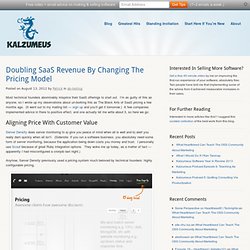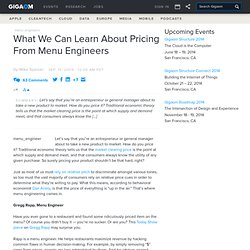

Don’t Blindly Model Your SaaS Pricing on 37signals. Doubling SaaS Revenue By Changing The Pricing Model. Most technical founders abominably misprice their SaaS offerings to start out.

I’m as guilty of this as anyone, so I wrote up my observations about un-borking this as The Black Arts of SaaS pricing a few months ago. (It went out to my mailing list — sign up and you’ll get it tomorrow.) A few companies implemented advice in there to positive effect, and one actually let me write about it, so here we go: Aligning Price With Customer Value Server Density does server monitoring to a) give you peace of mind when all is well and b) alert you really darn quickly when all isn’t. Anyhow, Server Density previously used a pricing system much beloved by technical founders: highly configurable pricing.
Why do geeks love this sort of pricing? I hate, hate, hate this pricing scheme. It costs $11 per server plus $2 per website.Except if you have more than 10 servers it costs $8 per server plus $2 per website.Except if you have more than 50 servers it costs $7 per server plus $2 per website. I love this. Using Behavioral Economics, Psychology, and Neuroeconomics to Maximize Sales. Camels and Rubber Duckies. By Joel Spolsky Wednesday, December 15, 2004 You've just released your latest photo-organizing software.

Through some mechanism which will be left as an exercise to the reader, you've managed to actually let people know about it. Maybe you have a popular blog or something. Maybe Walt Mossberg wrote a rave review in the Wall Street Journal. One of the biggest questions you're going to be asking now is, "How much should I charge for my software?
" So if you like cotton uniforms you better get this right. The answer is really complicated. Now. Some Economic Theory Imagine, for the moment, that your software costs $199. Pricing to the demand curve. Many college microeconomics courses include the following exercise.

The teacher offers the students an imaginary trip to Hawaii, and asks them to write down on notecards how much they are willing to pay for the trip. The teacher takes the notecards and graphs the bids. Here’s how the graph might look: The y-axis is the students’ “willingness-to-pay” and the x-axis is the students sorted from highest to lowest bids. The line is known as the demand curve. Now imagine you’re the company selling these trips. Your total revenue and (assuming zero marginal cost) profit will be the area of the green square (revenue times quantity). Notice the sections under the curve to the right and above the green box. Scientific way to price b2b software « cdixon posterous. How Perfect Pricing got me 1500 Sales in 2 Days. This is a guest post by Sacha Greif – a designer and entrepreneur who recently sold thousands of copies of a self-published eBook that shows how to design a user interface step by step.

He’s worked with multiple startups and is also the founder of Folyo, a service that helps companies find vetted freelance designers. Here, Sacha explains how he set the pricing for his eBook — a critical step in its success. My Dad recently chided me for buying cheap, store-brand brown bread. Since we also happened to have fancy imported Danish bread in the pantry, I challenged him to a blind taste test. Sure enough, he couldn’t tell the difference, despite one kind of bread costing twice as much as the other. Intuitively, we tend to see prices as a consequence of a product’s inherent worth, and marketers everywhere want to keep it that way.
I’ve always been fascinated by the power of pricing, as demonstrated by stories like the jeweler who doubled her sales by trippling her prices. Multi-axis Pricing: a key tool for increasing SaaS revenue. Scalable pricing is a powerful tool to grow revenue in a SaaS or software business. It allows you to capture more of the revenue that your customers are willing to pay, without putting off smaller customers that are not able to pay high prices.
What We Can Learn About Pricing From Menu Engineers. Let’s say that you’re an entrepreneur or general manager about to take a new product to market.

How do you price it? Traditional economic theory tells us that the market clearing price is the point at which supply and demand meet, and that consumers always know the utility of any given purchase. So surely pricing your product shouldn’t be that hard, right? Just as most of us must rely on relative pitch to discriminate amongst various tones, so too must the vast majority of consumers rely on relative price cues in order to determine what they’re willing to pay. What this means, according to behavioral economist Dan Ariely, is that the price of everything is “up in the air.” Gregg Rapp, Menu Engineer Have you ever gone to a restaurant and found some ridiculously priced item on the menu? Rapp is a menu engineer. Let’s give the strategy a try.
Company A: Silicon Valley Pricing Model Widget — Basic : $10,000.